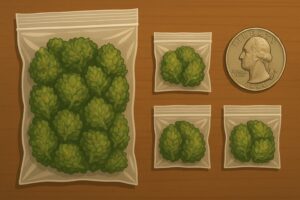Why does food taste better high? It’s a question almost every cannabis enthusiast has asked. Usually, somewhere between the first puff and the third slice of pizza.
The “munchies” aren’t just a stereotype; they’re a real, scientifically explainable phenomenon. That sudden craving for food and the incredible way everything tastes isn’t just in your imagination.
The truth is, cannabis genuinely changes how your brain perceives flavor, smell, and pleasure. It’s not only about getting hungry; it’s about how THC, the main psychoactive compound in cannabis, amplifies your sensory world.
Let’s dive into the science behind why food tastes better when you’re high, and how to make the most of it.
The Science of the Munchies
Most people think cannabis just makes you hungry, but that’s only half the story. The “munchies” happen because THC interacts with your endocannabinoid system, a network of receptors throughout the body that regulates things like mood, appetite, memory, and sensory perception.
When you consume cannabis, THC binds to CB1 receptors in your brain, especially in areas involved in hunger and sensory processing. This interaction can flip your internal switch from “I’m full” to “I could eat,” and it can make eating feel more rewarding.
A pivotal study in Nature Neuroscience helps explain why flavors seem so intense. Researchers showed that activating cannabinoid receptors in the olfactory system (your smell circuitry) heightens scent sensitivity, which in turn increases food intake.
Because flavor is largely a combination of taste and smell, this olfactory boost alone can make ordinary foods taste extraordinary when you’re high.
How Cannabis Changes Taste Perception
Cannabis doesn’t just make you crave food; it changes the way you experience it. Taste and smell are tightly intertwined.
Much of what we call “flavor” is actually driven by aroma. When THC is on board, your brain often pays more attention to sensory details: aroma, texture, temperature, and even color. That’s why a simple mac and cheese might suddenly taste gourmet, or why fruit seems unbelievably sweet and vivid.
There’s also evidence that taste buds themselves are part of the story. Our bodies produce natural cannabinoids (endocannabinoids) that help regulate appetite and palatability. A study in PNAS found that endocannabinoids selectively enhance sweet taste by acting on CB1 receptors co-expressed with sweet-taste machinery on the tongue.
Put simply, cannabinoids can turn up both the smell and certain aspects of taste, creating a fuller, more rewarding flavor experience.
Role of Dopamine: Why Food Feels So Rewarding
Beyond the senses, there’s the reward factor. THC can influence dopamine, a neurotransmitter tied to motivation and pleasure. When you eat something you love, dopamine helps deliver that “mmmmm” feeling.
Under THC, the reward you get from food can feel amplified. Not only do flavors pop, but the joy of eating pops, too.
This helps explain why familiar comfort foods (pizza, cookies, chocolate) are so appealing when you’re high. They already carry positive associations, and cannabis can intensify those feel-good signals.
Psychology of Being High
There’s a mindset component as well. Cannabis can nudge you into the present moment. Fewer racing thoughts, more focus on what’s right in front of you. That shift toward mindful eating makes textures crunchier, aromas bloomier, and flavors more layered. Slowing down and paying attention lets each bite register more deeply.
Lowered stress and social inhibitions can also make people more open to trying new flavor combinations or savoring foods they might otherwise rush through. The result is a richer, more immersive eating experience.
Best Foods to Eat When You’re High
Not all foods are created equal for the munchies. Some shine especially bright when your senses are dialed up:
1) Texture-Rich Snacks
Crunchy, crispy foods (chips, popcorn, pretzels, tempura, nut brittle) deliver satisfying sound + bite, which your heightened sensory state accentuates.
2) Flavor-Layered Dishes
Complex meals (tacos with multiple salsas, curries, ramen, BBQ, bánh mì) give you a parade of aromas and textures. Each bite feels new.
3) Sweet-Meets-Salty
Because the cannabinoid system can selectively boost sweet and you’ve got a primed reward circuit, combos like chocolate-covered pretzels, peanut butter + honey, or caramel popcorn hit multiple notes at once.
4) Fresh, Juicy, and Bright
Fruit (mango, pineapple, strawberries, citrus) tastes hyper-vivid, and the water content refreshes your palate between bites. Pro tip: mango is rich in myrcene, a terpene that many consumers say pairs nicely with certain strains’ effects.
5) Creative Pairings
Sparkling water + citrus peel, dark chocolate + espresso, spicy snacks + cooling dips, or creamy burrata + tomatoes and basil. Anything that layers contrast (hot/cold, crunchy/creamy, sweet/salty) plays beautifully with heightened senses.
And when you’re ready to pair your high with high-quality products, browse NorCal Holistics’ Flowers for premium selections.
Strains, Terpenes, and Pairing Ideas
Different strains and terpene profiles can complement different foods:
- Zesty, citrus-forward sativas (often high in limonene) pair well with fruit, ceviche, or bright salads.
- Earthy, relaxing indicas (frequently featuring myrcene or beta-caryophyllene) complement comfort foods, roasted dishes, or savory, umami-heavy meals.
- Herbal or piney profiles (think pinene) can cut through rich or creamy foods, keeping the palate feeling fresh.
Treat it like wine pairing: match intensity to intensity, and look for either harmony (similar flavors) or contrast (opposites that spark).
Tips for a Better High-Dining Experience
Eating while high can be more than just satisfying your cravings, it can be an art form. When your senses are heightened, every flavor, texture, and aroma becomes more vivid.
But to truly make the most of it, a few mindful habits can turn an ordinary snack into a full sensory experience. Here’s how to elevate your next high-dining moment:
- Start low, go slow. A little THC can sharpen senses; too much might dull them or make you sleepy.
- Set & setting matter. A relaxed, comfy environment helps you focus on taste.
- Hydrate. Water refreshes your palate and keeps flavors vivid.
- Mind the munchies. If you want balance, keep fresh fruit, nuts, or tasty protein on hand alongside indulgent snacks.
- Savor it. Take smaller bites, chew slowly, and let aromas do their work.
Savoring the Science
So, why does food taste better high? Because cannabis fine-tunes your body’s sensory systems. THC heightens smell (which drives flavor) and can enhance certain taste signals, especially for sweetness, while also making eating feel more rewarding and immersive. The result isn’t just wanting food; it’s experiencing food more intensely.
At Norcal Holistics, our weed delivery Sacramento love the intersection of science and enjoyment. When you understand how cannabis enhances your senses, you can enjoy more mindfully, responsibly, and deliciously.
Next time you indulge, slow down, take a bite, and notice how much more there is to taste.
Ready to taste better? Check out our affordable cannabis menu at NorCal Holistics.
Frequently Asked Questions
Does cannabis make all flavors taste better or just certain types?
Cannabis doesn’t enhance all flavors equally. THC tends to heighten sensitivity to sweet, salty, and fatty tastes. These foods trigger the brain’s reward system. Subtle or bitter flavors may not be as noticeably affected.
How does smoking or consuming cannabis affect my sense of smell and taste?
THC activates the brain’s olfactory and taste receptors, sharpening how we perceive scent and flavor. It makes aromas stronger and taste sensations more vivid, which is why familiar foods can seem unusually delicious when high.
Which foods tend to taste the best when high?
Foods with bold flavors or contrasting textures, like spicy tacos, sweet-salty snacks, fresh fruit, or creamy desserts, usually shine the most. Your enhanced senses pick up every crunch, spice, and sweetness more intensely.
Are there specific cannabis strains or terpenes that enhance the taste of food?
Yes. Citrus-rich sativas with limonene amplify bright, fruity flavors, while indica strains high in myrcene or caryophyllene pair well with savory, earthy dishes. Matching terpenes to food types can elevate your sensory experience.
Can the “munchies” effect make me overeat because food tastes better high?
It can. THC increases appetite and pleasure signals, which may lead to overeating if you’re not mindful. Keeping healthy, flavorful snacks nearby helps you enjoy the experience without overindulging.
Does tolerance or frequency of cannabis use affect how much food tastes better?
Yes. Regular users often develop tolerance to THC’s sensory effects, meaning the flavor enhancement may feel less intense over time. Taking short breaks can help reset your endocannabinoid system and restore that heightened taste sensitivity.



